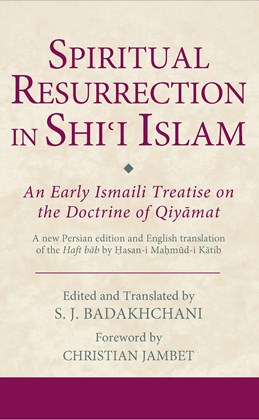Spiritual Resurrection in Shiʿi Islam An Early Ismaili Treatise on the Doctrine of Qiyāmat: A new Persian edition and English translation of the Haft bāb by Ḥasan-i Maḥmūd-i Kātib
I.B. Tauris in association with the Institute of Ismaili Studies
Of the few surviving Nizari Ismaili texts from the Alamūt period, the Haft bāb (Seven Chapters), which outlines the basic tenets of Ismaili philosophical theology, has proved to be the most popular. One of its many attractive features is its simple recounting of the most complicated Ismaili theological narratives, including the doctrine of the Resurrection (qiyāmat). Produced around the year 1203, this small treatise was probably intended as an introduction to the Diwān-i Qāʾimiyyāt compiled by Ḥasan-i Maḥmūd-i Kātib (d. after 1242). For many years, the Haft bāb was misattributed to Bābā Sayyidnā (Ḥasan-i Ṣabbāḥ), but the true author has finally been identified as Ḥasan-i Maḥmūd-i Kātib, whose works continue to shape our understanding of this important period.
The current text of the Haft bāb, edited and translated into English by S. J. Badakhchani, is based on Badakhchani's analysis of a great number of manuscripts available, including a complete and unaltered version. The concepts found in the text derive largely from the intellectual heritage of the Fatimids.These include the idea of tanzīh (the absolute transcendence of God beyond human understanding and knowledge); a cyclical conception of prophetic history, consisting of seven eras (dawr); the Ismaili Imamate as the most important pillar of Ismaili Islam; and the Qiyāmat as the completion and perfection of the religious law (shariʿāt).
The Ismaili interpretation of the Qiyāmat is radically different from Qur'anic eschatology in its esoteric formation, spiritual aspiration and imaginative scope. The Haft bāb explains this key doctrine of Nizari Ismailism, shedding light on a fundamental period in the history of Shiʿi Islam.
Acknowledgements
Foreword by Christian Jambet
Introduction
1. The author of Haft bāb 2. Content of the Haft bāb 3. Resurrection in Islam: An Overview
4. Resurrection in Fatimid Ismailism
5. Resurrection in Nizārī Ismailism
6. Proclamation of the Qiyāmat 7. The Ismaili Response
8. Contemporary Perspectives
9. Manuscripts and Editions
English Translation of Haft bābBibliography
Index
Persian Edition of Haft bāb
S.J Badakhchani is a Research Associate at The Institute of Ismaili Studies. He obtained his doctorate in Islamic Philosophy at the University of Oxford and his MA in Islamic Philosophy from the faculty of Theology University of Mashhad, Iran. He has been Deputy Director of the Central Library at Firdausi University, Mashhad, and Librarian at The Institute of Ismaili Studies, London. He has published new editions and English translations of Sayr wa-Sulūk and Rawdā-yi taslīm, as well as a collection of Ṭūsī's three short treatises, Aghaz wa anjam, Tawallā wa tabarrā and Maṭlūb al-Muʾmimīn. His most recent publication is a critical edition of the Dīwān-i Qāʾimiyyāt, the collected poems by Ḥasan-i Maḥmūd-i Kātib.

